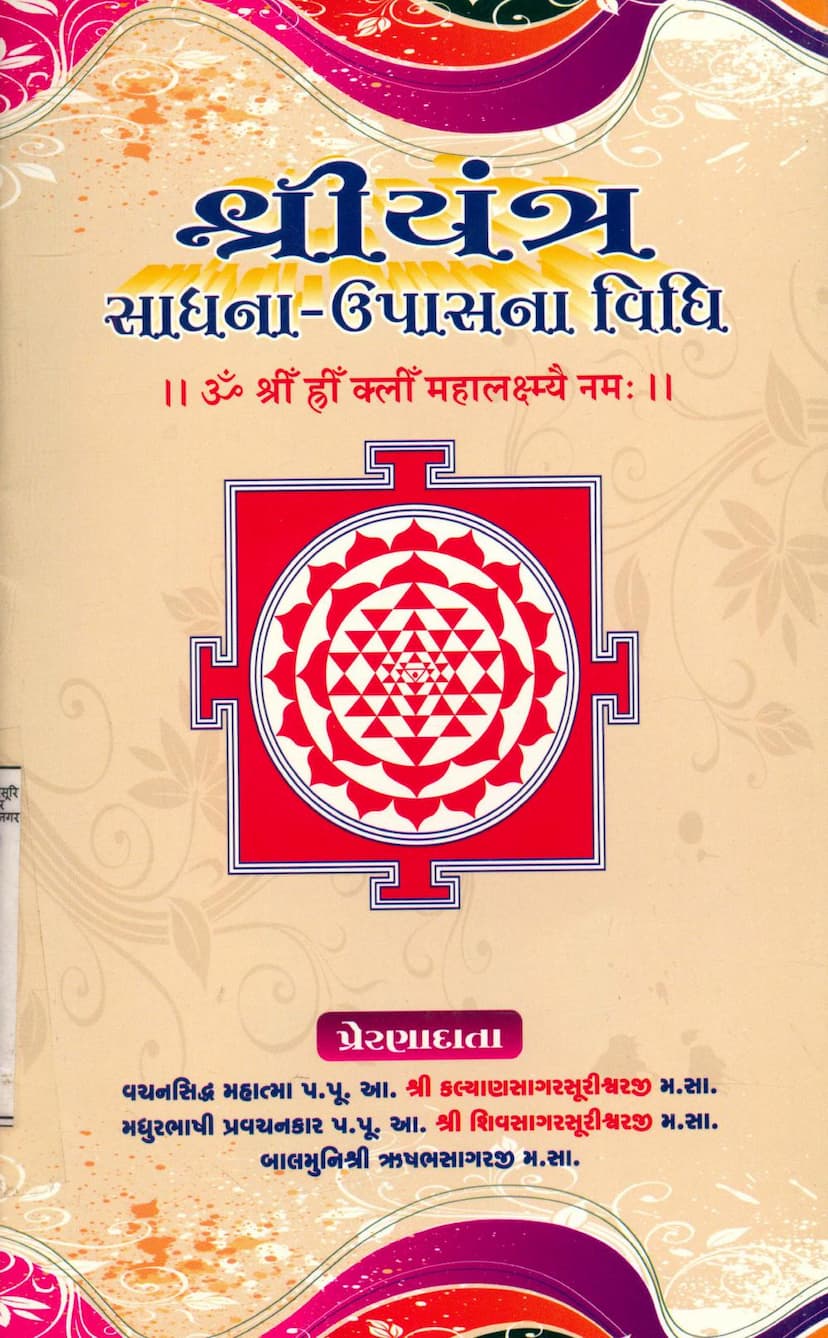Shreeyantra Sadhna Upasna Vidhi
Added to library: September 2, 2025

Summary
This document is a comprehensive guide to Shreeyantra Sadhna Upasna Vidhi (Worship and Practice of the Shree Yantra), a significant text within Jainism. The book is attributed to Acharya Kalyansagarsuri, Acharya Shivsagarsuri, and Balmunishri Rushabhsagarji. The publisher is Prafullchandra Jagjivandas Vora.
Here's a breakdown of the key themes and content presented in the provided pages:
1. Introduction and Spiritual Guidance:
- The book is presented with blessings from revered Jain Acharyas: Acharya Shri Kalyansagarsuri, Acharya Shri Shivsagarsuri, and Balmunishri Rushabhsagarji.
- It emphasizes the importance of mantra, yantra, and tantra in spiritual practice for the soul's progress.
- The Shree Yantra is highlighted as a "seed mantra" and a unique, Siddha (accomplished) yantra, representing Goddess Shri (Lakshmi). It is seen as a symbol of Lakshmi Devi.
2. Practical Applications and Benefits:
- The text suggests that the Shree Yantra is a simple and easily accessible yantra that can fulfill desires, purify homes (Vastu Shuddhi), and remove negative vibrations.
- It connects the worship of the Shree Yantra with attracting the grace and blessings of Goddess Lakshmi, which is considered essential for householders in managing their daily lives and fulfilling their responsibilities.
- The book explains that performing good deeds and spreading dharma (religion) requires financial resources, making Lakshmi's favor crucial for householders' well-being and spiritual advancement.
3. Rituals and Practices:
- Daily Puja: Detailed instructions are provided for daily worship, including bathing the Shree Yantra, applying perfumes, saffron, and sandalwood, offering flowers and rice, lighting a lamp and incense, and chanting specific mantras.
- Maha Puja (Grand Worship): This is recommended on auspicious days like Fridays, full moons, the beginning of the month, birthdays, the New Year, and other festivals. It involves all the daily puja rituals plus offering Naivedya (sweets), performing Aarti, and reciting stotras like Shri Sukta and Lakshmi Ashtakam.
- Mantra Chanting: Several powerful mantras for Goddess Lakshmi are provided, such as "Om Shreem Hreem Kleem Mahalakshmyai Namaha" and "Om Shreem Hreem Shreem Kamale Kamalalaye Prasid Prasid Shreem Hreem Shreem Mahalakshmyai Namaha." The text emphasizes the importance of faith and the proper chanting of these mantras.
- Specific Practices: The book details specific ritualistic actions like tying knots in a yellow silk thread while chanting a mantra (for 27 knots), offering Naivedya, and performing Aarti. It also mentions the significance of chanting on specific tithis (lunar days) like Pancham, Ashtam, and Poonam.
4. Importance of Purity and Devotion:
- The text stresses the importance of maintaining the purity of the Shree Yantra, using fresh puja materials, and not reusing offerings like flowers or Naivedya.
- It highlights that puja materials should be good and fragrant, and puja items should never be sniffed.
- A key instruction is to offer any wealth or items brought from outside into the Shree Yantra as prasad (blessed offering) before using them.
5. Guidance on Virtues and Actions:
- The book mentions a verse by Shri Hemchandracharya, suggesting that without engaging in righteous activities (Savadya Yoga), even the propagation of dharma is not possible, let alone householder life.
- It includes a poignant quote from a guru about the need for householders to be happy in all respects and for monks to undertake the necessary practices for their well-being, otherwise, the number of lay followers will decline, and the maintenance of Jain temples will face obstacles.
6. Specific Deities and Yantras:
- Shree Yantra: The central focus of the book.
- Ghantakarna Mahavir: Pages are dedicated to the construction of a Ghantakarna Mahavir Shakti Peeth, including details about massive bells, and fundraising for the project. The immense power of Ghantakarna Mahavir's mantra is highlighted.
- Sun Yantra and Mantra: The book includes a yantra and mantra for the Sun God, outlining its benefits such as removing poverty, enhancing influence, and aiding in modern health issues. It also recounts a historical instance where Acharya Vijay Hirsurishwarji used this mantra to influence Emperor Akbar.
- Ausadhī Māta (Panchanguli Devi): Mantras and rituals for this deity are provided, emphasizing her role as the guardian deity of Shri Simandhar Swami and the goddess of astrology. Her worship is said to bestow knowledge, prosperity, victory over enemies, and protection from troubles.
- Chmundā Devi: Mantras and rituals are given for Chamunda Devi, especially during Navratri, for fulfilling desires, gaining fame, wealth, victory, and good health.
- Sri Simandhar Swami: A mantra for daily chanting is provided, indicating the importance of devotion to this Tirthankar.
7. Biographical Information:
- The book includes detailed biographies of the esteemed Acharyas:
- Acharya Shri Shivsagarsuri: His lineage, spiritual journey, academic achievements (including inspiring a PhD on his Guru), and his mastery of Jyotisha, yantra, mantra, and tantra are described.
- Acharya Shri Kalyansagarsuri: His birth, initiation, attainment of various titles, and his expertise in sculpture and astrology are mentioned.
- Acharya Shri Buddhisagarsuri: His birth, initiation, establishment of Acharya title, and a remarkable prophecy about the future are presented.
8. Protection and Well-being:
- The text includes the Vajra Panjar Stotra, a powerful protective chant.
- Various mantras are offered for overcoming obstacles, protection from evil spirits, and general well-being.
In essence, "Shreeyantra Sadhna Upasna Vidhi" is a practical manual for Jain devotees seeking spiritual and material prosperity through the worship of Goddess Lakshmi and other significant deities and yantras, guided by the wisdom and practices of esteemed Jain Acharyas.